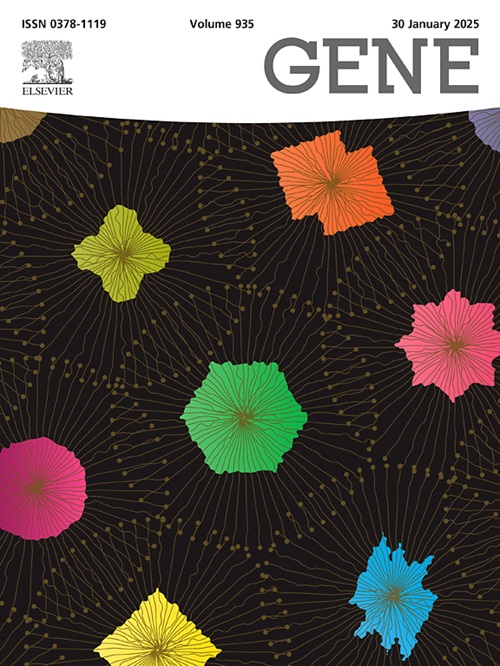Downregulation of glucose-energy metabolism via AMPK signaling pathway in granulosa cells of diminished ovarian reserve patients
IF 2.4
3区 生物学
Q2 GENETICS & HEREDITY
引用次数: 0
Abstract
Glucose metabolism plays a crucial role in the function of granulosa cells (GCs) and the development of follicles. In cases of diminished ovarian reserve (DOR), alterations in these processes can impact female fertility. This study aims to investigate changes in glucose-energy metabolism in GCs of young DOR patients aged 20 to 35 years and their correlation with the onset and progression of DOR. 72 DOR cases and 75 women with normal ovarian reserve (NOR) as controls were included based on the POSEIDON and Bologna criteria. Samples of GCs and follicular fluid (FF) were collected for a comprehensive analysis involving transcriptomics, metabolomics, RT-qPCR, JC-1 staining, and flow cytometry. The study identified differentially expressed genes and metabolites in GCs of DOR and NOR groups, revealing 7 common pathways related to glucose-energy metabolism, along with 11 downregulated genes and 14 metabolites. Key substances in the glucose-energy metabolism pathway, such as succinate, lactate, NADP, ATP, and ADP, showed decreased levels, with the DOR group exhibiting a reduced ADP/ATP ratio. Downregulation of genes involved in glycolysis (HK, PGK, LDH1), the TCA cycle (CS), and gluconeogenesis (PCK) was observed, along with reduced glucose content and expression of glucose transporter genes (GLUT1 and GLUT3) in DOR GCs. Additionally, decreased AMPK pathway activity and impaired mitochondrial function in DOR suggest a connection between mitochondrial dysfunction and disrupted energy metabolism. Above all, the decline in glucose-energy metabolism in DOR is closely associated with its onset and progression. Reduced glucose uptake and impaired mitochondrial function in DOR GCs lead to internal energy imbalances, hindering the AMPK signaling pathway, limiting energy production and supply, and ultimately impacting follicle development and maturation.
卵巢储备功能减退患者的颗粒细胞通过 AMPK 信号通路下调葡萄糖能量代谢。
葡萄糖代谢对颗粒细胞(GC)的功能和卵泡的发育起着至关重要的作用。在卵巢储备功能减退(DOR)的情况下,这些过程的改变会影响女性的生育能力。本研究旨在调查 20 至 35 岁年轻 DOR 患者颗粒细胞葡萄糖能量代谢的变化及其与 DOR 发病和进展的相关性。根据 POSEIDON 和博洛尼亚标准,纳入了 72 名 DOR 病例和 75 名卵巢储备功能正常(NOR)的女性作为对照。研究人员采集了GCs和卵泡液(FF)样本,进行了包括转录组学、代谢组学、RT-qPCR、JC-1染色和流式细胞术在内的综合分析。研究发现了 DOR 组和 NOR 组 GC 中表达不同的基因和代谢物,揭示了与葡萄糖能量代谢相关的 7 条共同通路,以及 11 个下调基因和 14 个代谢物。葡萄糖能量代谢途径中的关键物质,如琥珀酸、乳酸、NADP、ATP和ADP的含量均有所下降,其中DOR组的ADP/ATP比值降低。在 DOR 组 GC 中,参与糖酵解(HK、PGK、LDH1)、TCA 循环(CS)和葡萄糖生成(PCK)的基因下调,葡萄糖含量和葡萄糖转运体基因(GLUT1 和 GLUT3)的表达也有所降低。此外,DOR 中 AMPK 通路活性降低和线粒体功能受损表明线粒体功能障碍与能量代谢紊乱之间存在联系。总之,DOR 中葡萄糖能量代谢的下降与 DOR 的发病和进展密切相关。DOR GC 中葡萄糖摄取减少和线粒体功能受损会导致内部能量失衡,阻碍 AMPK 信号通路,限制能量的产生和供应,最终影响卵泡的发育和成熟。
本文章由计算机程序翻译,如有差异,请以英文原文为准。
求助全文
约1分钟内获得全文
求助全文
来源期刊

Gene
生物-遗传学
CiteScore
6.10
自引率
2.90%
发文量
718
审稿时长
42 days
期刊介绍:
Gene publishes papers that focus on the regulation, expression, function and evolution of genes in all biological contexts, including all prokaryotic and eukaryotic organisms, as well as viruses.
 求助内容:
求助内容: 应助结果提醒方式:
应助结果提醒方式:


